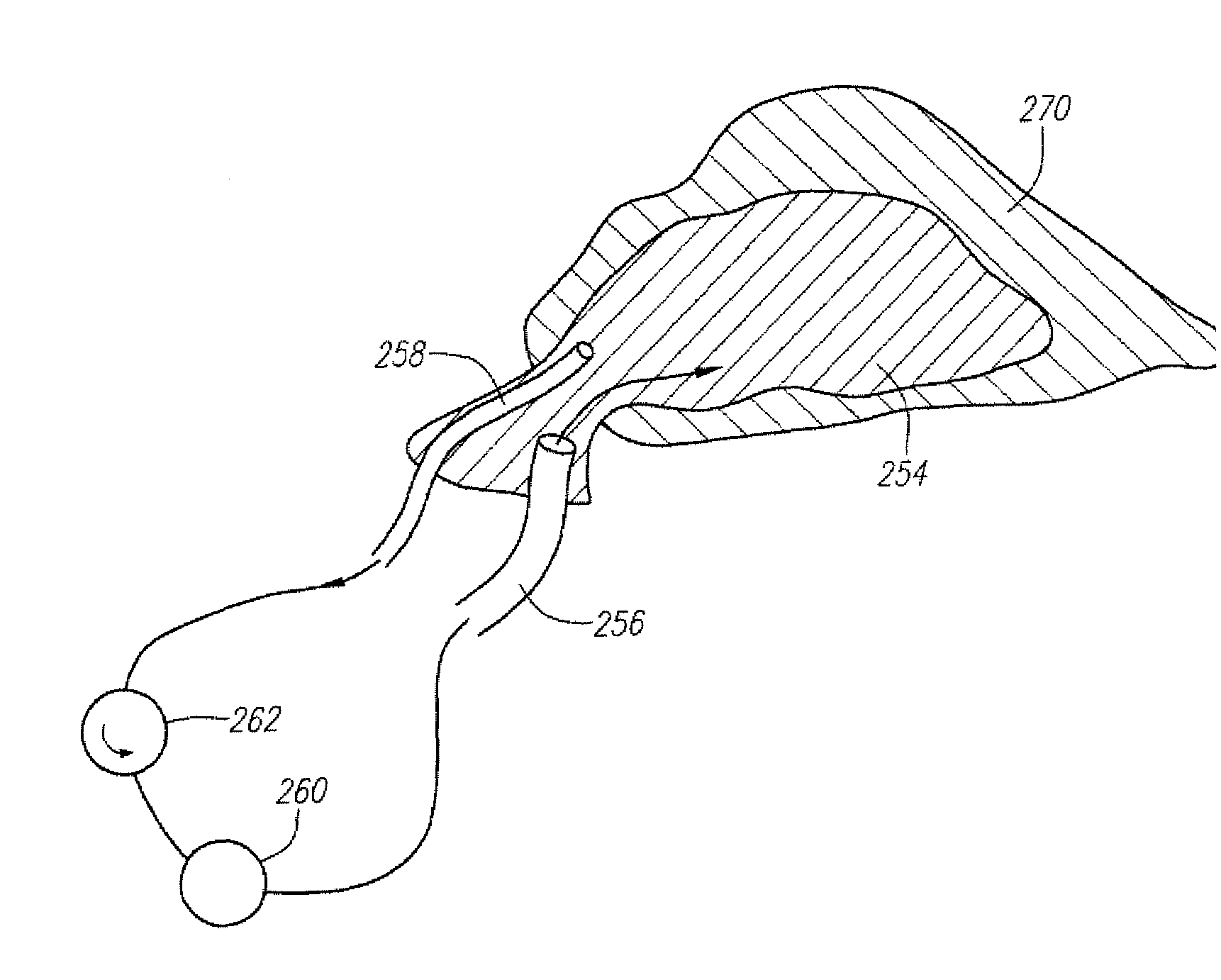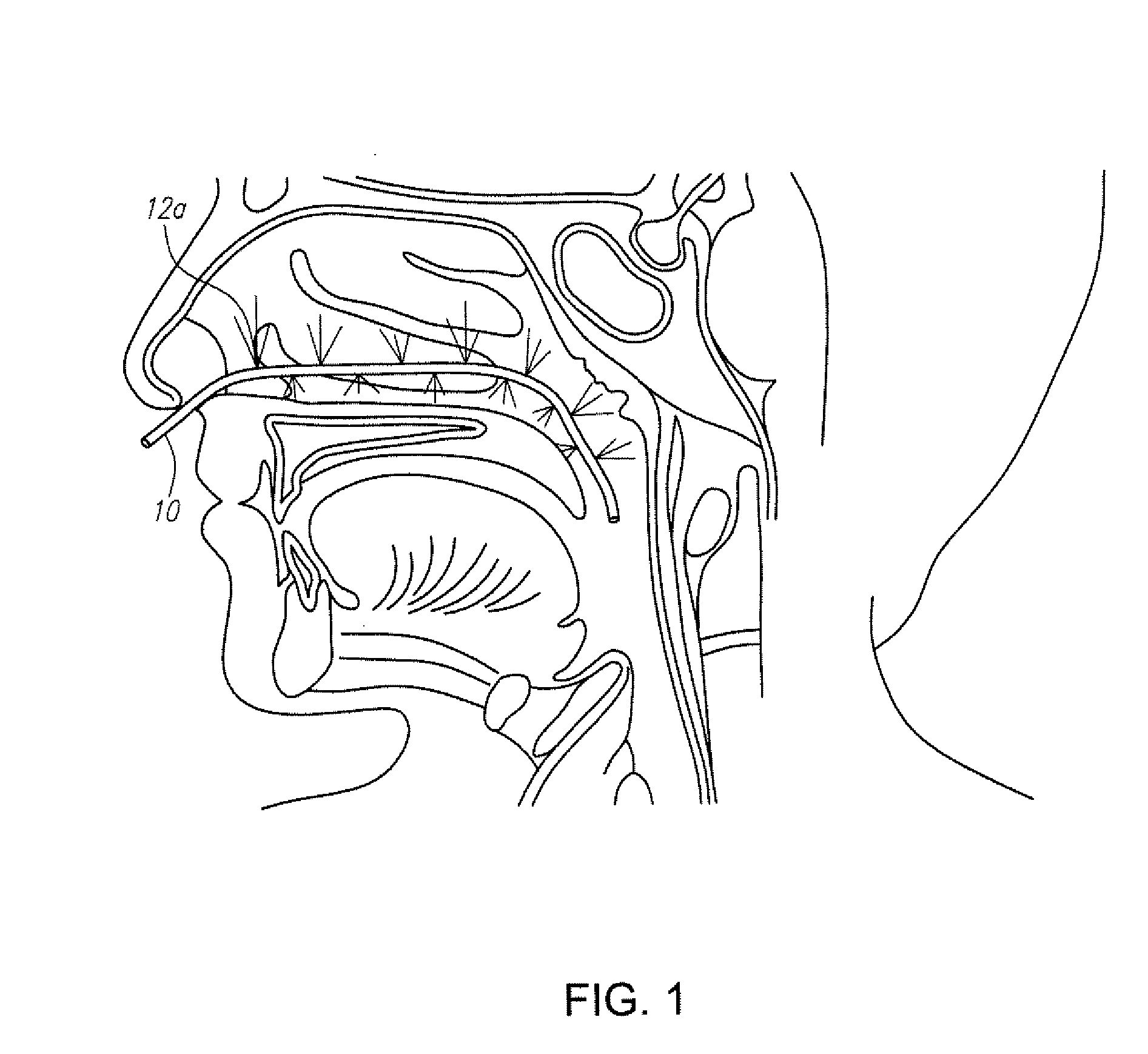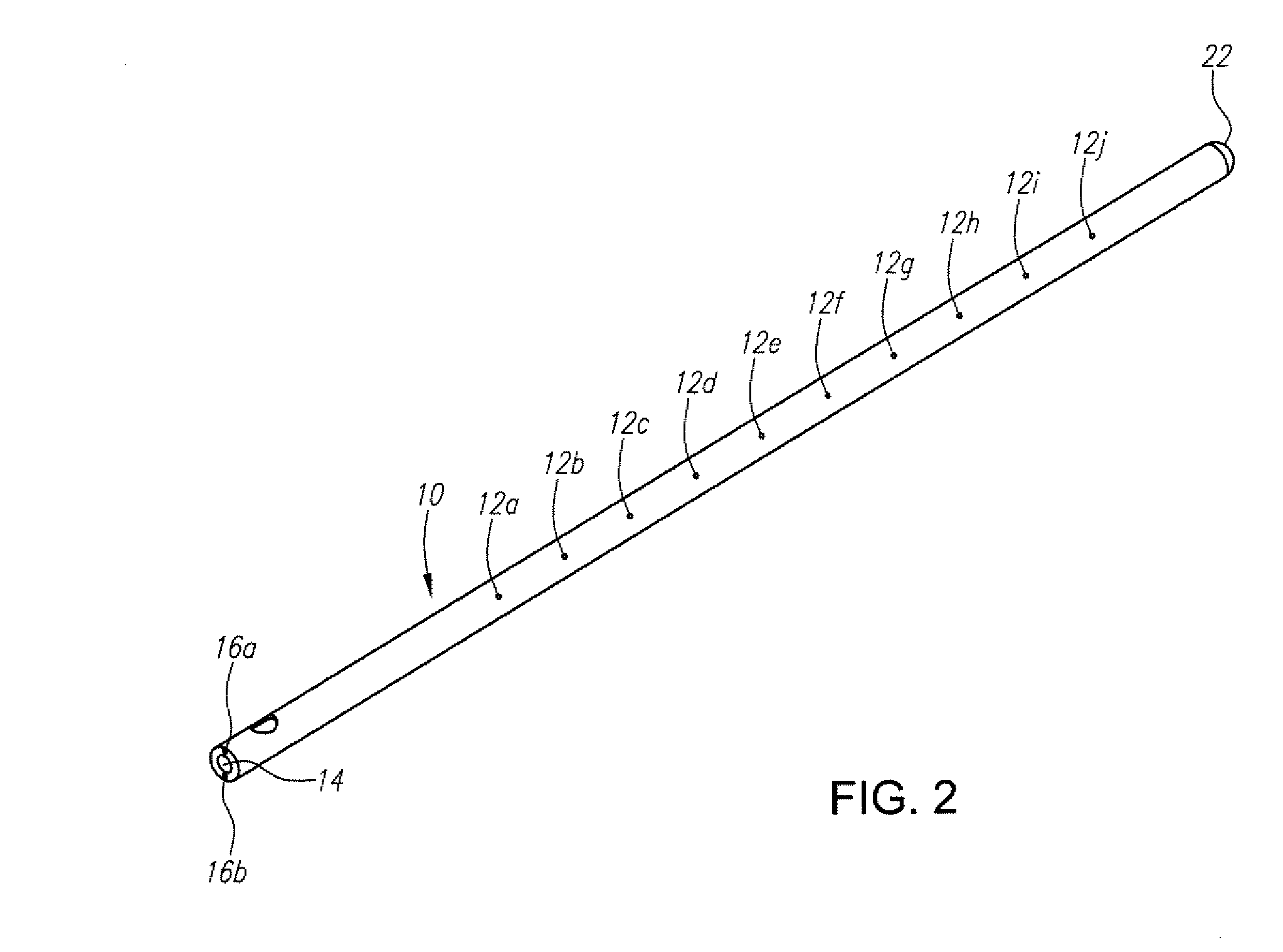[0009]The invention relates to methods, devices, and compositions for jugular, pharyngeal and / or cerebral cooling, preferably via the nasal and / or oral cavities. The cooling occurs by direct
heat transfer through the
pharynx as well as by hematogenous cooling through the carotids as they pass by the oropharynx and through the Circle of Willis, which lies millimeters away from the
pharynx. The direct cooling will be obtained through the heat loss of an ice slurry in the nasal cavity, oral cavity, and / or
throat. Additionally, cooling may occur through
convection in the nasal and / or oral cavities. Such cerebral cooling may help to minimize neurologic deficits in treating patients with either stroke or cardiogenic shock caused by reduced cerebral
perfusion or in the treatment of migraines. In the following description, where a cooling
assembly, device, or method is described for
insertion into a
nostril of a patient, a second cooling assembly or device can optionally also be inserted into the other
nostril to maximize cooling. Among the many important advantages of the present invention is patient safety by comparison with transpulmonary and intravascular
cooling methods and devices.
[0014]In other embodiments, a
slush or super-cooled gel can be circulated through the cooling assembly. In addition, a second cooling assembly could be inserted into the patient's other nostril to maximize pharyngeal and / or cerebral cooling.
[0016]In use, the cooling assembly is inserted into a patient's nostril. The chamber of the
balloon is infused with a slurry via the first and second lumens. The slurry is then withdrawn from the chamber through the lumens of the first and third tubular members. The chamber of the balloon expands to place the surface of the balloon in contact with the nasal cavity when the chamber is infused with slurry, such that a cerebral temperature of the patient is reduced by at least 1° C. in about one hour. The slurry can be continuously cooled and re-circulated through the chamber of the balloon using a pump or other means. The slurry could be an ice slurry, a
saline ice slurry, a perfluorocarbon ice slurry or any other suitable ice slurry. In other embodiments, a
slush or super-cooled gel can be circulated through the cooling assembly. A second cooling assembly could be inserted into the patient's other nostril to maximize cerebral cooling.
[0024]In an alternative embodiment of this invention, thin impermeable membranes surrounding a space may be placed over the
carotid arteries externally. For example, the membranes may extend from
clavicle to the ear lobe and be approximately 4 cm in width. The membranes may be cooled using a liquid perfluorocarbon, preferably with a
boiling point less than 37° C., delivered cold or at
room temperature. The membrane must be filled such that vapor can still escape. The membranes may be of a radiator shape to increase surface area. In addition, the membranes may have an inlet and a larger bore outlet.
Adhesive may be used to stick the membranes to the neck, e.g., like an EKG patch. Alternatively, a collar with cold patches confined to the carotid region may be used. The liquid in the membranes may be cold
saline, refrigerants, or perfluorocarbons with a
boiling point of above or below 37° C. Additionally, a vasodilator cream may be applied behind the cooling membrane to dilate vessels maximally.
[0027]In an alternative embodiment, the elongate tubular member may further comprise a second lumen having a port proximal to the expandable member whereby the melted slurry may be suctioned from the patient's nasal cavity. In addition, this melted slurry may be recycled for successive production of an ice slurry and delivery into the patient's nasal cavity. In addition, the elongate tubular member may further comprise a set of two expandable members located on the proximal end to occlude the nostrils and thus further isolate the nasal cavity and prevent fluid from leaking out of the patient's nostrils. In this embodiment, the elongate member may further include a third lumen extending between the distal and proximal ends of the elongate member and having an opening at the distal and proximal ends and for providing a
breathing passage through the nasal cavity while it is occluded by the expandable members. In use, the
catheter may be inserted into one of the patient's nostrils and positioned in the posterior aspect of the nasal cavity, proximal to the opening to the nasopharynx. Once positioned in posterior aspect of the nasal cavity, the one or more distal expandable members may be expanded to conform to the posterior aspect of the nasal cavity and form a seal isolating the nasal cavity from the nasopharynx while the two proximal expandable members may be expanded to occlude the patient's nostrils and isolate the nasal cavity. Once isolated, an ice slurry, for example a
saline ice slurry or a PFC ice slurry, may be delivered to the nasal cavity via a delivery lumen and suctioned out of the nasal cavity via a suction lumen. The nasal cavity is completely isolated so none of the liquid may leak to the
throat or run out the patient's nostrils however the suction lumen allows melted slurry to be removed from the nasal cavity so that cold ice slurry can be continuously introduced. Use of the distal and proximal expandable members to isolate the nasal cavity, however, may cause a pressure build up in the nasal cavity. To prevent such a pressure build-up, the expandable members may be made of a somewhat porous material such as
cork,
wool, cotton or any other slightly porous material known to those skilled in the art. The slightly porous material may prevent pressure build up while still preventing most
fluid leakage. In addition, the third lumen with openings on the proximal and distal ends of the elongate tubular member permits the patient to continue
breathing through his
nose even while the nasal cavity is isolated for treatment.
[0035]
Nitric oxide or
adrenergic agents, such as adrenaline (
epinephrine) or albuterol, may be added in minute doses to the compositions described in any of the previously described embodiments. The NO or other agent is inhaled and acts as a potent nasal vasodilator, which improves the rate of action of the slurry and counteracts nasal
vasoconstriction caused by administering cold substances to the nasal cavity. The NO may be included in an amount of about 2 to about 80 parts per million, in other cases in an amount of about 3 to about 20 parts per million, in other cases in an amount of about 4 to about 10 parts per million, in other cases in an amount of about 5 to about 8 parts per million, in other cases in an amount of about 5 parts per million. The ice slurry is delivered to the nasal cavity, oral cavity and or throat of a patient so that the ice slurry causes cerebral cooling by
heat transfer to the ice slurry to effect the
phase change of the suspended ice particles in the ice slurry. In addition indirect hematogenous cooling occurs through the carotids as they pass by the oropharynx and through the Circle of Willis which lies millimeters away from the
pharynx. The administration of the slurry is continued until the cerebral temperature is reduced to 35° C. or below, more preferably to 34° C. or below, more preferably to 33° C. or below. In certain methods, the administration of the slurry may be continued to provide for systemic cooling as well as cerebral cooling.
 Login to View More
Login to View More  Login to View More
Login to View More 


